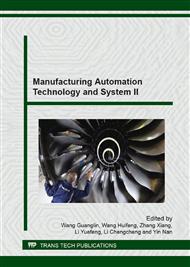p.38
p.44
p.51
p.57
p.63
p.69
p.75
p.82
p.88
Research on Vibration Characteristics of Hardened Steel Precision Machining Process
Abstract:
Hard cutting technology is a green cutting technology of broad application prospect, but hard cutting is more likely to produce vibration compared with traditional cutting, and the production efficiency, machining quality, environment, cost and machine tools and tool life will be affected by the precision in the process of hard cutting chatter. Turning hardened steel GCr15 cylindrical bar using PCBN inserts on the lathe CAK6150DI analyzed the cutting vibration signal characteristic in the different state of cutting tool; analyzed the related features of dynamic cutting force and cutting vibration signals; and observed the microstructure on the machined surface. Analysis results show that the vibration of smooth cutting state is given mainly with forced vibration and noise, vibration signals are produced with the typical characteristics of high range frequency in frequency zone, disperse frequency domain energy; When the cutting chatter, strong self-excited vibration appeared and occupied the main position of vibration signal energy, frequency domain energy is concentrated in nearly natural frequency of the main vibration system of the lower cutting. The results of the study can provide theoretical guidance for the control of vibration in hardened cutting process.
Info:
Periodical:
Pages:
63-68
Citation:
Online since:
August 2014
Authors:
Price:
Сopyright:
© 2014 Trans Tech Publications Ltd. All Rights Reserved
Share:
Citation:


